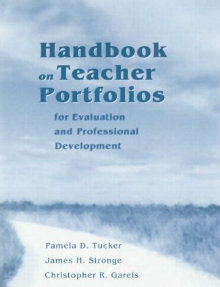Using Teacher Portfolios for Evaluation and PD
Handbook on Teacher Portfolios for Evaluation and Professional Development
By Pamela D. Tucker, James H. Stronge, and Christopher R. Gareis
(Routledge, 2002 – Learn more)
Reviewed by Diana Grady

In their preface they state their rationale and purpose straight-forwardly:
…portfolios have the potential to provide a more personal and meaningful approach to the ongoing analysis of daily practice…portfolios can help teachers consider what works and doesn’t work, how to improve practice, and how to capture the impact of teaching on students.” (p xv)

I enjoyed reading this 15-year old book (still in print!) for several reasons. The logical presentation make following their case easy. In addition, they offer myriad examples of possible portfolio styles.
Their explicit explanations and templates create a plan that would help teachers and administrators to create and support portfolios as an efficacious method of evaluation. However, they do not back away from showing the need for buy-in by the people involved, the training needed to compile the portfolio, and the ongoing reflection of the process.
What the book includes
In Chapter 1, “Handbook on Teacher Portfolios: an Introduction,” the authors define what is meant by a portfolio, what it offers the professional educator, and how it can be used for evaluation and professional development.
In Chapter 2, “Developing a Teacher Portfolio,” the individual teacher receives specific guidance on how to structure and develop an effective portfolio.
Chapter 3, “Putting Portfolios into Action,” provides a broader perspective on what to consider in the implementation of portfolios as a school or school system.
Chapter 4, “Teacher Portfolios and Teacher Evaluation,” and Chapter 5, “Teacher Portfolios and Professional Development,” explore the use of portfolios for these two interrelated purposes. I found these two chapters valuable for understanding the way portfolios can assist teachers to examine their own practice.
Chapter 6, “The Role of Portfolios for the Teaching Profession,” summarizes what the educational community has learned about portfolios and future directions for them.
The appendices include a variety of able-to-be-copied tools for structuring portfolios and organizing their components. A companion CD is supposed to be included but was not available in the text I received.
A strong case for the value of portfolios
As an experienced teacher and professional consultant, I appreciate the authors’ comprehensive, passionate presentation. They believe strongly in the value of portfolios. In their preface they conclude:
In the last few years, portfolios have given teachers a voice in selecting, presenting, and interpreting the work that they do as professionals. Portfolios have changed the paradigm, taking teachers from a passive role in evaluation and professional development to an active one-a professional one. This shift is long overdue.” (p xvi)
I especially appreciated their emphasis on portfolios as an opportunity for self-reflection. To take the time to review and reflect on practice is often the missing link between the mechanics of teaching and being a successful teacher.
I highly recommend Handbook on Teacher Portfolios. Even though it was published 15 years ago (and therefore lacks any focus on current digital tools), it offers a timely answer to the timeless question, “What does it mean to be a teacher?”
Diana Grady is Site Director for the Buzzards Bay Writing Project, a site of the National Writing Project. She taught seventh and eighth grade English Language Arts for 38 years before retiring to work with BBWP. Currently, as a writing consultant, she works on writing enrichment with third, fourth, and fifth graders.






























